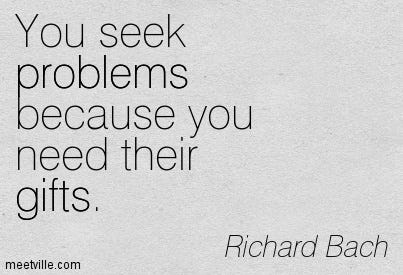Proactive Problem Solving: The Art of Finding Problems When there are None

PROBLEMS
There are problems of poverty.
There are problems of ill health.
There are problems of crime and corruption.
There are problems of environmental pollution.
There are problems of inefficient business processes.
There are innumerable problems. It is possible to address each problem and find a solution.
But there are many who feel problem solving takes too long. Particularly, remedying the root causes.
So we indulge in quick-fix problem solving. Band-aid problem solving.
With this negative attitude, problems surface again and again.
A negative attitude is useful for pointing out the problems, but inadequate for solving them.
If the attitude is right and constructive habits are in place, then problem solving is much easier. It can trigger a positive revolution.
PROBLEM SOLVING: NOT JUST FOR OPERATIONS

I can think of no better example than Akshaya Patra for a positive revolution in India.
Akshaya Patra Foundation proactively embraced the elephant size problem of classroom hunger and malnutrition in India, in 2000. The symptoms of the problem needed no data gathering. The benefits from solving this problem were obvious:
· Improved ability to focus and learn in class
· Improved school attendance
· Improved socialization among castes
· Vocational opportunity for women.
We all know that problems scheduled for solution need to be specific, observable and measurable. They also need to be of a size that is manageable. So the focus for the first project was Bangalore, H K Hill.
The first step in problem solving is to understand stakeholders needs. In this case it was: South Indian cuisine; balanced meals; interesting meals. Akshaya Patra designed the menus for non-repetitive, nutritious and interesting meals.
But how do you service 100,000 children daily? How do you ensure hygienic practices in the kitchen processes? How do you ensure quality inputs and no avoidable waste? How do you ensure on-time delivery of perfect hot meals? How do you build a quality culture in the organization? Etc, etc, etc.

The answer lay in adoption of world-class kitchen technology and world-class quality practices. There was simply no room for error. The solution to the challenge had to follow the mantra: better, faster, cheaper, and different.
The Bangalore kitchen proved a successful pilot. Today Akshaya Patra has over 20 kitchens. Their reach varies from 10,000 to 100,000 students, at each kitchen.

In conclusion, if you are sitting on a pin, you can remove the pin. All is well.
However, most problems are much more complex. It is not a matter of removing the pin.
Most problems require a constructive and creative approach. An approach that exploits the left- and right-brain.
That is what the positive revolution is about. It’s about Proactive Problem Solving.
There are 4 Steps to Problem Solving:
· Problem Definition
· Problem Diagnosis
· Problem Remedy
· Locking the Improvement
These 4 Steps can solve problems of poverty, ill health, crime and corruption, environmental pollution, and inefficient business processes.
——————

*The MADE IN INDIA tiger is a creative representation of the idea behind becoming a manufacturing behemoth in the global markets. Any resemblance to any other logo, is purely unintentional.
——————
Click here to see more blogs
Click here to buy his new book: Quality Fables?—?now available on Amazon Kindle

——————

Great Work Suresh. Inspiring writing. Very timely and topical.
Hope to hear more from you
warmly
Zerxis